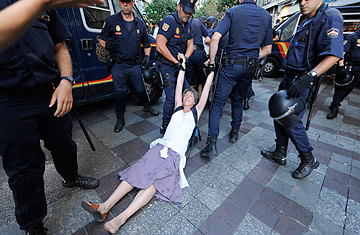
Police officers detain a protester at Puerta del Sol in Madrid on Aug. 2, 2011
At 8 p.m. on Wednesday, Madrid's Puerta del Sol — the city's geographical and spiritual center — once again looked like a ghost town. Normally at that hour, the square bustles with commuters descending into the subway station, shoppers hitting the department stores and scads of tourists lining up for ice cream and guided bus rides. But for the past two days, the Puerta del Sol has been virtually empty at rush hour. The metro shuts down, the shops close, and the square's only occupants are a hundred or so police officers intent on preventing the return of the protesters who took over the Puerta del Sol nearly three months ago.
For just like that, the Indignant are back. Days ago, the only physical remains of their movement were a few banner-strewn tarps posing as an information center and a handful of ragtag demonstrators taking naps in the afternoon sun. But on Tuesday and Wednesday, the movement revived, sending thousands of protesters into Madrid's streets. For that revival, the authorities have no one to blame but themselves.
By early June, the massive sit-ins that had turned plazas throughout Spain into tent cities occupied by demonstrators angry about corruption, spiraling unemployment and what they said was a lack of political representation had largely dissipated. In their place, the so-called Indignant took to holding occasional neighborhood assemblies, participating in efforts to impede housing evictions and organizing various symbolic acts, like a protest that brought demonstrators from all parts of the country to Madrid on July 23. Throughout, they maintained a small, if ramshackle, presence in the Puerta del Sol in the form of the information center and the few hard-core protesters who stayed to maintain it.
On Tuesday, however, the authorities apparently decided they had had enough of even that. Early that morning, the municipal and national government jointly sent in police to clear the square of the handful of protesters asleep there and dismantle the structures. By the afternoon, news of the police action had spread, and hundreds of protesters began to converge on Sol. In an effort to keep the square free of them, police first began screening passersby and eventually blocked their entry altogether. At 6 p.m., even access to subway and commuter trains at what is one of the biggest stations in the capital was closed.
In response, the protesters took to the streets, their numbers growing rapidly to several thousand as word of their march spread over Twitter and Facebook. Around midnight, they finally ended up in the Plaza Mayor, a historic square not far from the Puerta del Sol. There, as police helicopters circled noisily overhead, the Indignant decided to mount another attempt to "take back" Sol on Wednesday night.
Abruptly closed subway stations? Police helicopters? Many of the protesters — to say nothing of ordinary Spaniards — seemed shocked that, suddenly, it had come to this. "It just seems disproportionate," says demonstrator Aida Fernandez, 30, pointing to a cordon of some 20 police officers in riot gear from her position behind a barrier. "There was just almost nothing left. I don't understand why they would make such a big deal of it."
But her friend Manuel Serra thinks he understands the reason. "They want to clean the square before the Pope's visit," he says, referring to a trip that Benedict XVI is making to Madrid in mid-August to celebrate World Youth Day. His opinion was shared by the many of the protesters, who, blocked by riot police when they attempted to reach Sol on Wednesday, chanted things like "This isn't the Pope's Youth Day" and "Fewer crucifixes, more stable work" (it sounds better in Spanish).
The executive director of World Youth Day denies that the organization had anything to do with the eviction. "We did not request this," says Yago de la Cierva. "These decisions come from the government. We at World Youth Day prefer that everyone have the freedom to express their opinions, as long as they do it peacefully and respectfully." A spokesman for the national government's delegation in Madrid also rejected any correlation between the papal visit and the police action.
But if not the Pope, then what? None of the politicians ultimately responsible for the action — not the mayor of Madrid, not the Interior Minister — have made public statements about the decision to clear the square. And their underlings' response has been decidedly vague, if well-coordinated. "The operation was carried out at an opportune moment with an eye to causing the least possible damage," said the delegation spokesman. At the Interior Ministry, communications director Maria José Gallego repeated the same explanation almost word for word.
Still, the ministry did seem to take an antagonistic view toward the protesters. Asked earlier in the day whether the plaza would again be closed that night, Gallego replied, "Well, it would absurd of me to give away police strategy, wouldn't it?"
Sure enough, on the second night of the Indignant's attempt to reclaim the Puerta del Sol, things got a little tense between demonstrators and officers, as the former tried unsuccessfully to push through the cordon. But protester Ester, an 18-year-old student who didn't want to give her last names, wasn't worried. Thrusting her sign reading "Freedom of Expression" into the night sky, she said with a grin, "So they don't let us in tonight. We'll just be back tomorrow."
